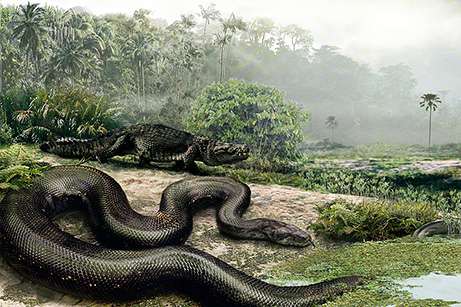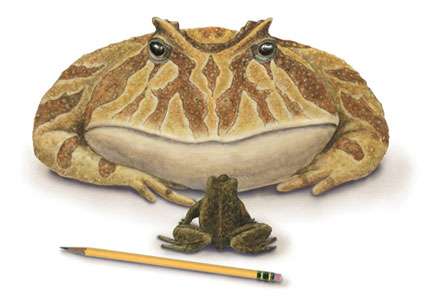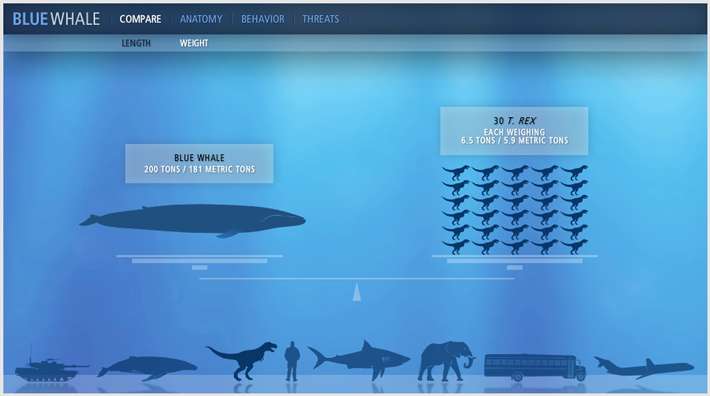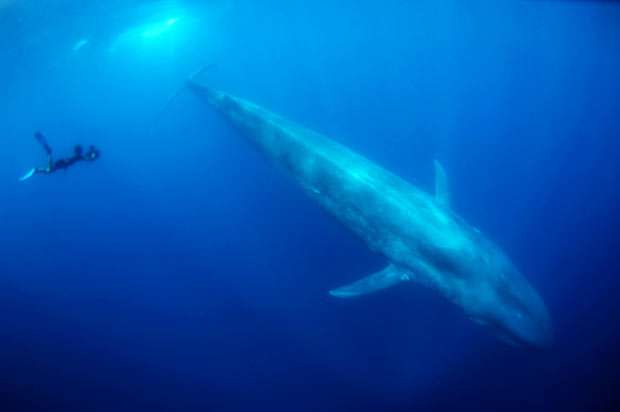It looks like you're using an Ad Blocker.
Please white-list or disable AboveTopSecret.com in your ad-blocking tool.
Thank you.
Some features of ATS will be disabled while you continue to use an ad-blocker.
11
share:
These creatures are amazing and I often wondering what would be our life on Earth if they were still there?
1. Biggest Snake Discovered; Was Longer Than a Bus

Illustration of Titanoboa cerrejonensis by Jason Bourque/ Released by Nature

Precloacal vertebra of an adult Green Anaconda dwarfed by a vertebra of the giant boid snake Titanoboa cerrejonensis (photo credit Kenneth Krysko) and (lower photo) comparison of a vertebra of Titanoboa with the body of a live Python regius (photo credit Jason Head)
2. Giant “Frog From Hell” Fossil Found in Madagascar

See the four other creature in the original paper at National Geographic
There are:
- A giant prehistoric rat which skull measure 53 centimeters (21 inches) long
- A penguin about the size of humans
- The world's largest [8.2-foot (2.5-meter), bigger than a man..] known bug that ever lived on Earth: the 390-million-year-old sea scorpion called Jaekelopterus rhenaniae.
- The famous megalodon that weighed up to 30 times more than the largest great white shark.
- A giant kangaroo-like beast...
But the biggest beast that ever lived on Earth, even bigger than any dinosaurs, is still the Blue Whale, with 30 metres (98 ft) in length and 180 metric tons (200 short tons)...


We all know about the size of dinosaurs, of course, but how about a rodent the size of a bull, a sea scorpion bigger than a man, a frog as large as a beach ball, a penguin the size of a small adult human, a 1,000-pound ground-sloth-like marsupial, and a shark that may have grown longer than 50 feet and weighed up to 30 times more than the largest modern great white?All these titans existed, although not in the same place or period.
Read on for pictures and more about seven of the biggest animals of all time.
1. Biggest Snake Discovered; Was Longer Than a Bus

Illustration of Titanoboa cerrejonensis by Jason Bourque/ Released by Nature
The biggest snake that ever lived (that we know about) was a massive anaconda-like beast that slithered through steamy tropical rainforests about 60 million years ago feasting on primitive crocodiles, National Geographic News reported today.
“Fossils discovered in northeastern Colombia’s Cerrejon coal mine indicate the reptile was at least 42 feet (13 meters) long and weighed 2,500 pounds (1,135 kilograms),”

Precloacal vertebra of an adult Green Anaconda dwarfed by a vertebra of the giant boid snake Titanoboa cerrejonensis (photo credit Kenneth Krysko) and (lower photo) comparison of a vertebra of Titanoboa with the body of a live Python regius (photo credit Jason Head)
The snake would have killed its prey by slow suffocation — wrapping around it and squeezing, just like a modern python or boa. Only this snake was twice the size of today’s largest constrictors.
Humans would stand no chance against one of these giant snakes, said Hans-Dieter Sues, paleontologist and associate director for research and collections at the National Museum of Natural History of the Smithsonian Institution in Washington, D.C. “Given the sheer size, the sheer cross section of that snake, it would be probably like one of those devices they use to crush old cars in a junkyard.”
2. Giant “Frog From Hell” Fossil Found in Madagascar

Scientists working in Madagascar found what may be the largest frog that ever lived, National Geographic News reported a year ago.
The bad-tempered Beelzebufo, or “devil frog” was a “rather intimidating animal the size of a beach ball, 16 inches (41 centimeters) high and weighing about 10 pounds (4.5 kilograms).”
Paleontologist David Krause of Stony Brook University in New York and his colleagues began unearthing the the 70-million-year-old frog as a specimen in bits and pieces more than a decade earlier. “Over the years a 75-piece puzzle emerged that was only recently put together by fossil-frog expert Susan Evans of University College London,” National Geographic’s story said.
Evans, lead author of a paper detailing the find, said that, like its closest modern-day relatives — a group of big-mouthed frogs in South America called ceratophyrines — the devil frog also probably had a very aggressive temperament.”These ceratophyrines are really aggressive, ambush predators. They are round with big mouths, and they will sit there and grab onto anything that walks past.”
“They’re sometimes called Pac-Man frogs,” she added, “and even the little ones will go for you. It’s a frog with attitude, even today. And at two or three times the size of the largest living ceratophyrines, Beelzebufo would have had quite a lot more attitude.”
The animal sported a protective shield and powerful jaws that may have enabled it to kill hatchling dinosaurs, National Geographic News reported.
See the four other creature in the original paper at National Geographic
There are:
- A giant prehistoric rat which skull measure 53 centimeters (21 inches) long
- A penguin about the size of humans
- The world's largest [8.2-foot (2.5-meter), bigger than a man..] known bug that ever lived on Earth: the 390-million-year-old sea scorpion called Jaekelopterus rhenaniae.
- The famous megalodon that weighed up to 30 times more than the largest great white shark.
- A giant kangaroo-like beast...
But the biggest beast that ever lived on Earth, even bigger than any dinosaurs, is still the Blue Whale, with 30 metres (98 ft) in length and 180 metric tons (200 short tons)...


I've been trying to find a clip or photo, but the one that always gets me is the mega-centipede. There was a series on the BBC 'Nigel Marven's
Prehistoric Park' where he used a time machine to go back and capture one for his safari park...and the thing was a beast.
I see the trollish post got all the stars, how sad.
I would like to thank you OP for bringing this article to light. The creatures described in it are amazing and wondrous, if not frightening to imagine living with them.
In the Ops article it states
Back to the contradiction. As stated above the Smithsonian has made an episode entitled "Titanoboa: Monster Snake"(I had the full episode embedded but the uploader has dismantled embedding you can see it in full here on you tube... www.youtube.com...). On their announcement page for this episode it states
What really got me into this search was the pictures presented on the article and also shown in the OP. What bothered me is that the give a misrepresentation of size. Someone who does not read the article and get the actual sizes AND knows the size of the creatures being set beside them in the pictures gets an unrealistic size assessment. Clearly the pictures are reversed as the description states the "lower photo" is the living Python regius but thats no big issue. What is the issue is that a Python regius was used in the comparison. The Python regius, also known as the Ball Python has a maximum length of about 5 feet. This is about the quarter of the average size of the modern green anaconda or Eunectes murinus which should have been the example, as the fossil was an anaconda type Boidae, which is a boa and not a python at all. I could have understood if they compared it to a Reticulated Python(Broghammerus reticulatus) because although the Anaconda is the longest the Reticulated python is the biggest in girth.
Because this post has become so long I will shift to generalizations, sorry. The same type of misrepresentation can be said with the use of a drawing of a common frog in comparison to a Louisiana bullfrog instead of our largest species of frog and its prehistoric counterpart. Our largest frog is called commonly the Goliath Frog and you can read about it here frogsaregreen.com... it is currently on the endangered species list due to deforestation and habitat destruction.
And yet again the lack of use of the largest penguin, the Emperor Penguin. My point is, is that this article was written by National Geographic and one would think they could have better representations and less "find some pics and throw it together" type articles. The article was well written and has some great information it's just too bad the writer or editor, which ever is responsible, could not have added equally well chosen pictures.
Good find OP the information was great.
I would like to thank you OP for bringing this article to light. The creatures described in it are amazing and wondrous, if not frightening to imagine living with them.
In the Ops article it states
The article was written February 4, 2009. Knowing that the Smithsonian recently put out an episode entitled "Titanoboa: Monster Snake" I went to their announcement page for this show and found a contradiction. This bothered me as the Smithsonian was in charge of the investigation in the first place. All the news reports and articles from the time, based on the February 4th 2009 article published in "Nature" magazine which were the official findings of the Smithsonian, state the same information as the article the OP linked making the report credible.
“Fossils discovered in northeastern Colombia’s Cerrejon coal mine indicate the reptile was at least 42 feet (13 meters) long and weighed 2,500 pounds (1,135 kilograms),” contributor John Roach reported today.
Back to the contradiction. As stated above the Smithsonian has made an episode entitled "Titanoboa: Monster Snake"(I had the full episode embedded but the uploader has dismantled embedding you can see it in full here on you tube... www.youtube.com...). On their announcement page for this episode it states
which is a difference in size of 6 feet and 806 pounds give or take. So my question is, was there a mistake in the original investigation by the Smithsonian or have they embellished upon the findings?
Slithering in at 48 feet long and weighing an estimated one-and-a-half tons smithsonianscience.org...
What really got me into this search was the pictures presented on the article and also shown in the OP. What bothered me is that the give a misrepresentation of size. Someone who does not read the article and get the actual sizes AND knows the size of the creatures being set beside them in the pictures gets an unrealistic size assessment. Clearly the pictures are reversed as the description states the "lower photo" is the living Python regius but thats no big issue. What is the issue is that a Python regius was used in the comparison. The Python regius, also known as the Ball Python has a maximum length of about 5 feet. This is about the quarter of the average size of the modern green anaconda or Eunectes murinus which should have been the example, as the fossil was an anaconda type Boidae, which is a boa and not a python at all. I could have understood if they compared it to a Reticulated Python(Broghammerus reticulatus) because although the Anaconda is the longest the Reticulated python is the biggest in girth.
Because this post has become so long I will shift to generalizations, sorry. The same type of misrepresentation can be said with the use of a drawing of a common frog in comparison to a Louisiana bullfrog instead of our largest species of frog and its prehistoric counterpart. Our largest frog is called commonly the Goliath Frog and you can read about it here frogsaregreen.com... it is currently on the endangered species list due to deforestation and habitat destruction.
And yet again the lack of use of the largest penguin, the Emperor Penguin. My point is, is that this article was written by National Geographic and one would think they could have better representations and less "find some pics and throw it together" type articles. The article was well written and has some great information it's just too bad the writer or editor, which ever is responsible, could not have added equally well chosen pictures.
Good find OP the information was great.
edit on 28-6-2012 by Agarta because: (no reason given)
I was hoping for living beasts. I know dinosaurs were humungous, but I want something still alive.
Any one want to list the largest living animals?
I will give you a head start:
World's longest/largest alligator - 1890 - caught in Marsh Island, Louisiana - 19'-2" * (weight officially unknown, but estimations range between 2,000 lbs. to 2,300 lbs.) See: www.shannontech.com/ParkVision/Everglades/Everglades.html
Read more: wiki.answers.com...
Any one want to list the largest living animals?
I will give you a head start:
World's longest/largest alligator - 1890 - caught in Marsh Island, Louisiana - 19'-2" * (weight officially unknown, but estimations range between 2,000 lbs. to 2,300 lbs.) See: www.shannontech.com/ParkVision/Everglades/Everglades.html
Read more: wiki.answers.com...
reply to post by elevenaugust
WoW that's a big snake and animals. You know one of the things I always wondered was what would something that big such as that huge snake or a Trex, well what would it taste like. But some of those animals were huge that bull sized Rat well dam that thing could probably feed a whole tribe for a month, that is one big ass rat.
In all I think there are very good reasons why they all went extinct, and size matters but not all that much it seems, as pretty much all the larger species in history have gone extinct or minimized and even today the larger species seem to be lagging behind and drifting compared to some of there more smaller cousins.
But it seems that its been pretty consistent that the larger species have been going extinct all through out history and its not only the fossils that show this.
What the planet can support and what the ecosystem is willing to support no doubt plays a part in it all, and they just require to much upkeep for them to be around today. But that cant be all there is to it. And then just for the sh*tz and giggles and just to throw a monkey wrench into things. Hey why not! Lets play with crazy theories like expanding planets. And what if?
WoW that's a big snake and animals. You know one of the things I always wondered was what would something that big such as that huge snake or a Trex, well what would it taste like. But some of those animals were huge that bull sized Rat well dam that thing could probably feed a whole tribe for a month, that is one big ass rat.
In all I think there are very good reasons why they all went extinct, and size matters but not all that much it seems, as pretty much all the larger species in history have gone extinct or minimized and even today the larger species seem to be lagging behind and drifting compared to some of there more smaller cousins.
But it seems that its been pretty consistent that the larger species have been going extinct all through out history and its not only the fossils that show this.
What the planet can support and what the ecosystem is willing to support no doubt plays a part in it all, and they just require to much upkeep for them to be around today. But that cant be all there is to it. And then just for the sh*tz and giggles and just to throw a monkey wrench into things. Hey why not! Lets play with crazy theories like expanding planets. And what if?
Originally posted by Agarta
I see the trollish post got all the stars, how sad.
I would like to thank you OP for bringing this article to light. The creatures described in it are amazing and wondrous, if not frightening to imagine living with them.
In the Ops article it statesThe article was written February 4, 2009. Knowing that the Smithsonian recently put out an episode entitled "Titanoboa: Monster Snake" I went to their announcement page for this show and found a contradiction. This bothered me as the Smithsonian was in charge of the investigation in the first place. All the news reports and articles from the time, based on the February 4th 2009 article published in "Nature" magazine which were the official findings of the Smithsonian, state the same information as the article the OP linked making the report credible.
“Fossils discovered in northeastern Colombia’s Cerrejon coal mine indicate the reptile was at least 42 feet (13 meters) long and weighed 2,500 pounds (1,135 kilograms),” contributor John Roach reported today.
Back to the contradiction. As stated above the Smithsonian has made an episode entitled "Titanoboa: Monster Snake"(I had the full episode embedded but the uploader has dismantled embedding you can see it in full here on you tube... www.youtube.com...). On their announcement page for this episode it stateswhich is a difference in size of 6 feet and 806 pounds give or take. So my question is, was there a mistake in the original investigation by the Smithsonian or have they embellished upon the findings?
Slithering in at 48 feet long and weighing an estimated one-and-a-half tons smithsonianscience.org...
What really got me into this search was the pictures presented on the article and also shown in the OP. What bothered me is that the give a misrepresentation of size. Someone who does not read the article and get the actual sizes AND knows the size of the creatures being set beside them in the pictures gets an unrealistic size assessment. Clearly the pictures are reversed as the description states the "lower photo" is the living Python regius but thats no big issue. What is the issue is that a Python regius was used in the comparison. The Python regius, also known as the Ball Python has a maximum length of about 5 feet. This is about the quarter of the average size of the modern green anaconda or Eunectes murinus which should have been the example, as the fossil was an anaconda type Boidae, which is a boa and not a python at all. I could have understood if they compared it to a Reticulated Python(Broghammerus reticulatus) because although the Anaconda is the longest the Reticulated python is the biggest in girth.
Because this post has become so long I will shift to generalizations, sorry. The same type of misrepresentation can be said with the use of a drawing of a common frog in comparison to a Louisiana bullfrog instead of our largest species of frog and its prehistoric counterpart. Our largest frog is called commonly the Goliath Frog and you can read about it here frogsaregreen.com... it is currently on the endangered species list due to deforestation and habitat destruction.
And yet again the lack of use of the largest penguin, the Emperor Penguin. My point is, is that this article was written by National Geographic and one would think they could have better representations and less "find some pics and throw it together" type articles. The article was well written and has some great information it's just too bad the writer or editor, which ever is responsible, could not have added equally well chosen pictures.
Good find OP the information was great.edit on 28-6-2012 by Agarta because: (no reason given)
You just addressed everything I was silently considering. I think they purposely embellish to get people interested in what "may" be an otherwise dry subject.
There seems to b e a huge gap between the mind of the average individual and that of scientists.
For example, when scientists find a new and unique species of mushroom they may become excited to be part of the discovery. However the regular person out there unless its compared in a fashion that makes the object in question as unique to them as it is to the scientists, they will probably dismiss it as uninteresting.
It's akin to NASA embellishing the characteristics of new planets they find.
In other words....They talk to you like a child.
I'm glad the Boid Snake isn't slithering around anymore. Yikes!
reply to post by CallYourBluff
Best laugh I had all day!
reply to post by CallYourBluff
Best laugh I had all day!
As scary as it may seem, the Titanoboa is probably NOT the largest snake that ever existed. Fossil remains found in Argentina and called
"Chubutophis" have been suggested as belonging to an even larger snake, up to 20 or so meters long.
Madtsoia (a giant snake that coexisted with dinosaurs and survived the late Cretaceous extinction by a few million years) was probably also larger (at least some species), with some estimates giving it a length of 10-15 meters, although unfortunately, the remains are fragmentary.
Also, since Madtsoia was not a boid but a madtsoiid, its jaws were not as flexible and it may have been unable to swallow prey as large as Titanoboa. Oh well...
Madtsoia (a giant snake that coexisted with dinosaurs and survived the late Cretaceous extinction by a few million years) was probably also larger (at least some species), with some estimates giving it a length of 10-15 meters, although unfortunately, the remains are fragmentary.
Also, since Madtsoia was not a boid but a madtsoiid, its jaws were not as flexible and it may have been unable to swallow prey as large as Titanoboa. Oh well...
new topics
-
Paradox of Progress
Ancient & Lost Civilizations: 7 hours ago -
Joe Biden gives the USA's Highest Civilian Honor Award to Hillary Clinton and George Soros.
US Political Madness: 9 hours ago -
Winter Storm
Fragile Earth: 10 hours ago
top topics
-
Joe Biden gives the USA's Highest Civilian Honor Award to Hillary Clinton and George Soros.
US Political Madness: 9 hours ago, 13 flags -
What Is 'Quad Demic'? Mask Mandate Returns In These US States
Diseases and Pandemics: 16 hours ago, 11 flags -
The Future of fashion .
Social Issues and Civil Unrest: 17 hours ago, 8 flags -
Winter Storm
Fragile Earth: 10 hours ago, 7 flags -
Bin Cyber Junk…
Short Stories: 17 hours ago, 6 flags -
A great artist and storyteller, for kids of all ages
General Entertainment: 12 hours ago, 5 flags -
Biden Face Planted Somewhere
Politicians & People: 12 hours ago, 5 flags -
Paradox of Progress
Ancient & Lost Civilizations: 7 hours ago, 5 flags
active topics
-
What Is 'Quad Demic'? Mask Mandate Returns In These US States
Diseases and Pandemics • 30 • : butcherguy -
The Future of fashion .
Social Issues and Civil Unrest • 19 • : Cloudbuster1 -
Winter Storm
Fragile Earth • 19 • : RazorV66 -
Post A Funny (T&C Friendly) Pic Part IV: The LOL awakens!
General Chit Chat • 7988 • : KrustyKrab -
Paradox of Progress
Ancient & Lost Civilizations • 3 • : BingoMcGoof -
Here we again... CHINA having mass outbreak of something
Diseases and Pandemics • 24 • : NoCorruptionAllowed -
A great artist and storyteller, for kids of all ages
General Entertainment • 1 • : angelchemuel -
-@TH3WH17ERABB17- -Q- ---TIME TO SHOW THE WORLD--- -Part- --44--
Dissecting Disinformation • 3931 • : RelSciHistItSufi -
Joe Biden gives the USA's Highest Civilian Honor Award to Hillary Clinton and George Soros.
US Political Madness • 29 • : caterpillage -
NJ Drones tied to Tesla explosion at Trump Las vegas
General Conspiracies • 45 • : glen200376
11
